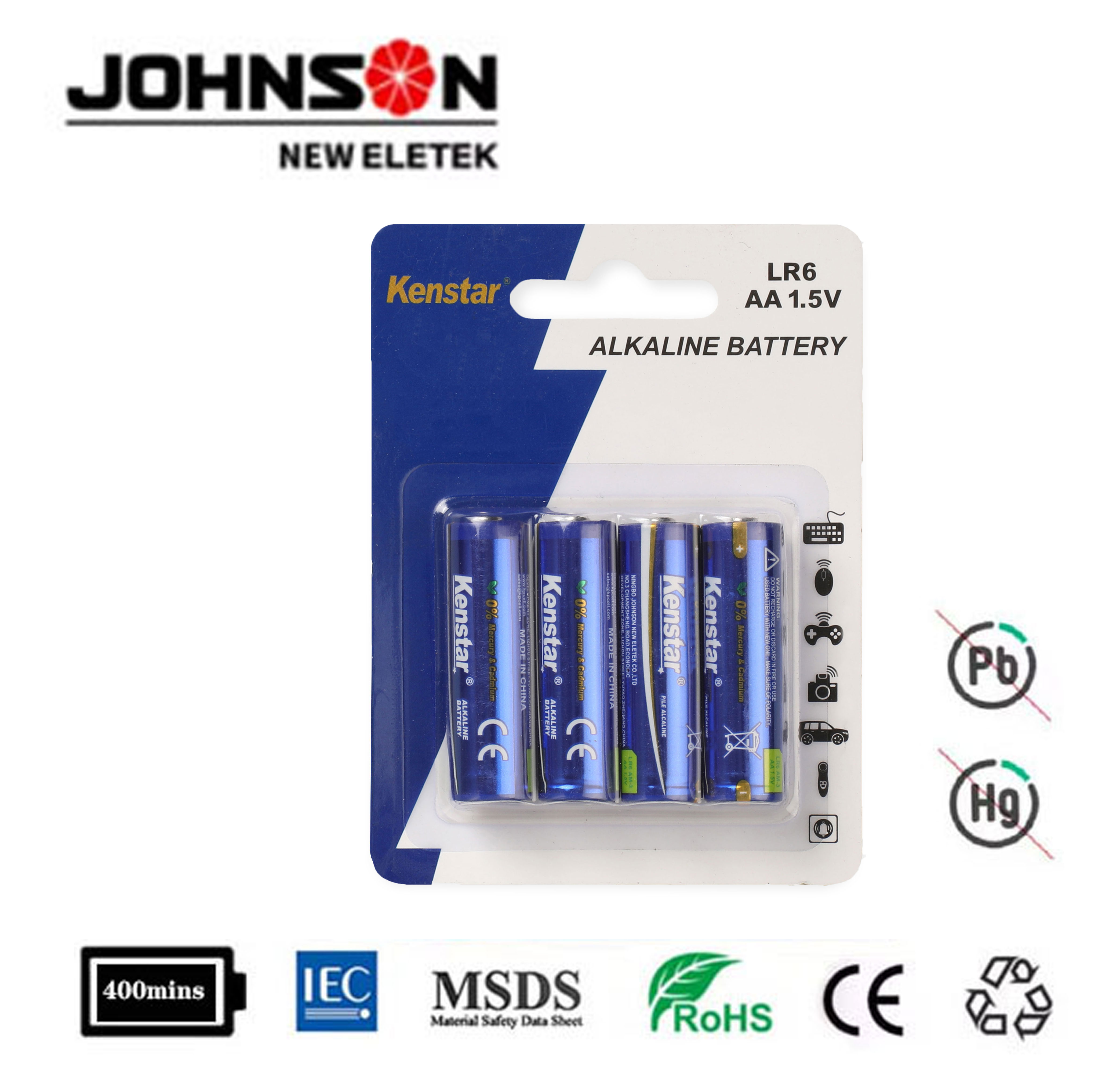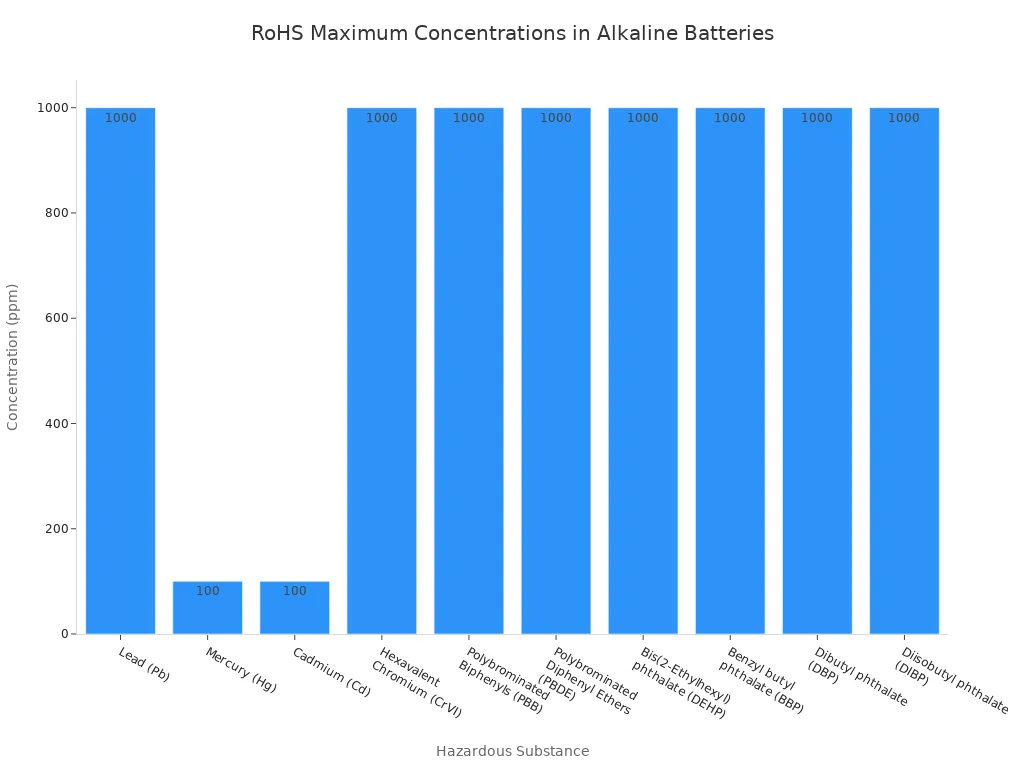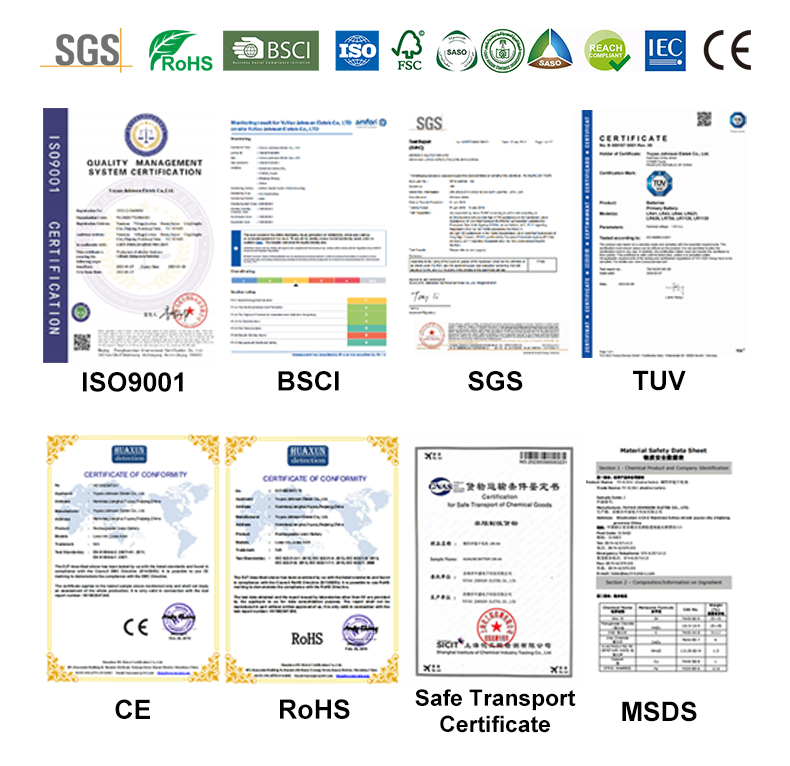
I recognize that for an alkaline battery, CE marking is the most critical certification in the EU. For the U.S., I focus on compliance with federal regulations from the CPSC and DOT. This is crucial, especially as the U.S. market alone projects to reach USD 4.49 billion by 2032, underscoring the vast importance of these standards.
Key Takeaways
- Alkaline batteries need different rules in the EU and the U.S. The EU uses one main rule called CE marking. The U.S. has many rules from different groups.
- Following these rules helps keep people safe. It also protects the environment. This means batteries do not have bad chemicals and are thrown away correctly.
- Meeting these rules helps companies sell their batteries. It also builds trust with customers. This shows the company cares about safety and quality.
Mandatory Certifications for Alkaline Batteries in the European Union (EU)

CE Marking: Ensuring Conformity for Alkaline Batteries
I understand CE marking is a critical requirement for placing products, including alkaline batteries, on the European Union market. This mark signifies a product’s conformity with EU health, safety, and environmental protection legislation. It is not a quality mark, but rather a declaration by the manufacturer that the product meets all applicable EU directives and regulations.
When I consider the specific technical standards and directives CE marking for alkaline batteries references, I find it points to several key documents:
- Battery Directive
- RoHS Directive
- prEN IEC 60086-1: Primary batteries – Part 1: General
- prEN IEC 60086-2-1: Primary batteries – Part 2-1: Physical and electrical specifications of batteries with aqueous electrolyte
I know non-compliance with CE marking requirements carries significant consequences.
According to Article 20(5) of the EU Regulation 2023/1542 on Batteries and Waste Batteries: “Member States shall build upon existing mechanisms to ensure correct application of the regime governing the CE marking and shall take appropriate action in the event of improper use of that marking.”
In instances where a product, subject to the CE marking mandate, is found devoid of said marking or bears it unlawfully, the respective government of the member state is empowered to institute regulatory measures. These actions may encompass market withdrawal and the imposition of penalties. Accountability rests with manufacturers, importers, and/or authorized representatives in cases of illicit CE marking or non-conformance with EU harmonized standards.
Non-compliance with CE marking requirements for batteries in the EU can lead to:
- Seizure and destruction of products by customs authorities.
- Confiscation of revenue.
- Immediate suspension of affected listings for Amazon sellers.
EU Battery Directive: Specific Requirements for Alkaline Batteries
I recognize the EU Battery Directive plays a central role in regulating batteries within the European market. This directive aims to minimize the negative impact of batteries on the environment and human health. It sets specific requirements for the design, production, and disposal of batteries, including alkaline batteries.
New European regulations, effective May 2021, mandate specific requirements for alkaline batteries. These include a mercury content limit of less than 0.002% by weight (ideally mercury-free) and the inclusion of capacity labels. These labels must indicate the energy capacity in watt-hours for AA, AAA, C, and D sizes. Additionally, alkaline batteries must meet eco-efficiency criteria to ensure efficient energy storage throughout their lifespan. The directive also requires all batteries to feature a sign or symbol indicating their capacity. While the directive does not specify a metric standard, capacity can be indicated using units such as V, mAh, or Ah. Furthermore, any battery containing more than 0.004% lead must display the symbol ‘Pb’ on its labeling, even though lead content itself is not restricted.
WEEE Directive: End-of-Life Management for Alkaline Batteries
I understand the Waste Electrical and Electronic Equipment (WEEE) Directive primarily addresses the end-of-life management of electronic products. While the WEEE Directive covers a broad range of electronics, the EU has a specific directive for batteries and accumulators, separate from the WEEE Directive. This dedicated directive aims to reduce hazardous materials and establish environmentally sound treatment for waste batteries.
Producers of batteries and accumulators are required to register in each country where they sell, report quantities, and finance the compliant treatment of end-of-life batteries. The national battery Extended Producer Responsibility (EPR) framework considers all battery chemistries, including alkaline, as well as small (single-use and rechargeable) and mid-format batteries. The obligations under the battery directive are similar to those under the WEEE Directive in terms of administrative and financial requirements, but they are distinct.
Producer responsibilities for end-of-life management of batteries include:
- Obtain a registration number (unique identification number UIN).
- Contract with a producer responsibility organization.
- Report quantities and weights of batteries placed on the market.
REACH Regulation: Chemical Safety for Alkaline Batteries
I know the REACH Regulation (Registration, Evaluation, Authorisation, and Restriction of Chemicals) is another crucial piece of EU legislation. It aims to improve the protection of human health and the environment from the risks that chemicals can pose. REACH applies to substances manufactured or imported into the EU, including those found within alkaline batteries. It requires companies to identify and manage the risks linked to the substances they manufacture and market in the EU.
RoHS Directive: Restricting Hazardous Substances in Alkaline Batteries
I recognize the RoHS Directive (Restriction of Hazardous Substances) directly impacts the composition of alkaline batteries. This directive restricts the use of specific hazardous materials found in electrical and electronic products. Its goal is to prevent these substances from harming human health and the environment.
The RoHS Directive sets maximum permissible concentrations for various hazardous substances. I have outlined these limits in the table below:
| Hazardous Substance | Maximum Allowable Concentration |
|---|---|
| Lead (Pb) | < 1000 ppm |
| Mercury (Hg) | < 100 ppm |
| Cadmium (Cd) | < 100 ppm |
| Hexavalent Chromium (CrVI) | < 1000 ppm |
| Polybrominated Biphenyls (PBB) | < 1000 ppm |
| Polybrominated Diphenyl Ethers (PBDE) | < 1000 ppm |
| Bis(2-Ethylhexyl) phthalate (DEHP) | < 1000 ppm |
| Benzyl butyl phthalate (BBP) | < 1000 ppm |
| Dibutyl phthalate (DBP) | < 1000 ppm |
| Diisobutyl phthalate (DIBP) | < 1000 ppm |
I also find this chart helpful for visualizing these restrictions: 
These regulations ensure that products, including alkaline batteries, sold in the EU meet stringent safety and environmental standards.
Key Regulations and Standards for Alkaline Batteries in the United States (U.S.)

CPSC Regulations: Consumer Safety for Alkaline Batteries
In the United States, I look to the Consumer Product Safety Commission (CPSC) for ensuring consumer safety. The CPSC protects the public from unreasonable risks of injury or death associated with consumer products. While the CPSC does not have specific regulations solely for alkaline batteries, these batteries fall under their general authority to ensure product safety. I understand manufacturers must ensure their alkaline battery products do not present a substantial hazard. This includes preventing issues like leakage, overheating, or explosion that could harm consumers. The CPSC can issue recalls or require corrective actions if a product, including an alkaline battery, is found to be unsafe. I always prioritize designing products that meet these fundamental safety expectations.
DOT Regulations: Safe Transport of Alkaline Batteries
I also consider the Department of Transportation (DOT) regulations for the safe transport of alkaline batteries. The DOT sets rules for packaging, labeling, and handling hazardous materials during shipment by air, sea, or ground. For alkaline batteries, I find they are generally classified as non-hazardous for transport. This means they do not typically require the stringent regulations applied to lithium-ion batteries, for example. However, I still ensure proper packaging to prevent short circuits or damage during transit. My company adheres to relevant sections of 49 CFR (Code of Federal Regulations) Part 173, which outlines general requirements for shipments and packaging. This ensures our products reach their destination safely and compliantly.
State-Specific Regulations: California Proposition 65 and Alkaline Batteries
When I consider selling products across the U.S., I pay close attention to state-specific regulations, especially California Proposition 65 (Prop 65). This law requires businesses to provide warnings to Californians about significant exposures to chemicals that cause cancer, birth defects, or other reproductive harm. If an alkaline battery contains any of the chemicals on the Prop 65 list, even in trace amounts, I must provide a clear and reasonable warning label. This regulation impacts how I label products for the California market, ensuring consumers receive necessary information about potential chemical exposures.
Voluntary Industry Standards: UL and ANSI for Alkaline Batteries
Beyond mandatory regulations, I recognize the importance of voluntary industry standards in the U.S. These standards often define best practices and enhance consumer confidence. Underwriters Laboratories (UL) and the American National Standards Institute (ANSI) are two key organizations. UL develops safety standards and performs product testing and certification. A UL listing on a product, while voluntary for alkaline batteries, signifies compliance with rigorous safety standards. ANSI coordinates the development of voluntary consensus standards. For portable batteries, I often refer to the ANSI C18 series of standards. These standards cover dimensions, performance, and safety aspects of batteries. Adhering to these voluntary standards demonstrates my commitment to quality and safety.
FCC Label: Relevance for Certain Alkaline Battery Products
I understand the Federal Communications Commission (FCC) regulates interstate and international communications by radio, television, wire, satellite, and cable. An FCC label is typically required for electronic devices that emit radio frequency (RF) energy. A standalone alkaline battery does not emit RF energy, so it does not require an FCC label. However, if an alkaline battery is an integral component of a larger electronic device that does emit RF energy—such as a wireless remote control or a smart home device—then the device itself must undergo FCC certification. In such cases, the battery is part of a certified product, but the FCC label applies to the end device, not the battery alone.
Why These Certifications Matter for Alkaline Batteries
Ensuring Market Access and Legal Compliance
I understand that certifications are not just bureaucratic hurdles; they are essential gateways to market access. For me, ensuring legal compliance means my products can be sold without interruption in key markets like the EU and U.S. The EU Battery Regulation, for instance, applies to all manufacturers, producers, importers, and distributors of every type of battery placed within the EU market. This includes U.S. companies that produce batteries or electronics containing batteries if they export to the EU. Non-compliance carries significant financial risks. I know that maximum administrative fines in the EU can reach €10 million, or up to 2% of the total annual worldwide turnover from the preceding financial year, whichever amount is higher. This emphasizes the critical need for adherence to these regulations.
Protecting Consumers and the Environment
I believe these certifications play a vital role in protecting both consumers and the environment. By adhering to standards like RoHS and the EU Battery Directive, I ensure my products are free from harmful substances and designed for responsible end-of-life management. This commitment safeguards consumer health by preventing exposure to dangerous chemicals and minimizes environmental impact through proper disposal and recycling practices. It reflects my dedication to sustainable and safe product development.
Building Trust and Brand Reputation
For me, achieving these certifications is about building trust and enhancing my brand reputation. When my products meet stringent international standards, it signals quality and reliability to consumers and business partners alike. This commitment to compliance demonstrates my company’s integrity and responsibility. It fosters confidence in my products, which is invaluable for long-term success and market leadership.
Comparing EU and U.S. Certification Approaches for Alkaline Batteries
Mandatory CE Marking vs. Fragmented U.S. Landscape
I observe a clear distinction in certification approaches between the EU and the U.S. The EU employs a unified system with CE marking. This single mark signifies an alkaline battery’s compliance with all relevant EU directives. It acts as a comprehensive passport for market entry across all member states. This streamlined process simplifies compliance for manufacturers like me. In contrast, the U.S. landscape is significantly more fragmented. I navigate a patchwork of federal agencies like the CPSC and DOT, each with specific regulations governing different aspects of product safety and transport. Additionally, state-specific laws, such as California Proposition 65, introduce further requirements. This means I address multiple regulatory bodies and diverse standards to ensure full compliance for my products in the U.S. market. This multi-faceted approach demands careful attention to detail for each jurisdiction.
Shared Goals of Safety and Environmental Protection
Despite their differing regulatory structures, I find both the EU and U.S. share fundamental goals. Both prioritize consumer safety above all else. They aim to protect users from potential product hazards, ensuring that items are safe for their intended use. Environmental protection also stands as a critical common objective. Regulations in both regions seek to minimize the environmental impact of products throughout their lifecycle. This includes stringent restrictions on hazardous substances, as seen in the EU’s RoHS Directive and similar concerns in the U.S. Furthermore, both regions promote responsible end-of-life management, encouraging recycling and proper disposal. I ensure my products meet these shared objectives, regardless of the specific certification pathway. My commitment to safety and sustainability remains constant across all markets I serve.
I confirm CE marking is paramount for EU market access, ensuring compliance with health and safety standards. For the U.S., I navigate CPSC, DOT, and voluntary industry standards. This comprehensive compliance is crucial. It ensures my products reach consumers safely and legally, protecting both people and my brand’s reputation in these vital markets.
FAQ
What is the main difference between EU and U.S. battery certifications?
I find the EU uses a unified CE marking. The U.S. relies on a combination of federal agency regulations and state-specific laws.
What happens if my alkaline batteries do not meet these certifications?
I know non-compliance can lead to market access denial, product seizures, and significant financial penalties. It also damages my brand reputation.
Why are these certifications important for alkaline batteries?
I believe these certifications ensure consumer safety and environmental protection. They also guarantee legal market access for my products.
Post time: Oct-24-2025




